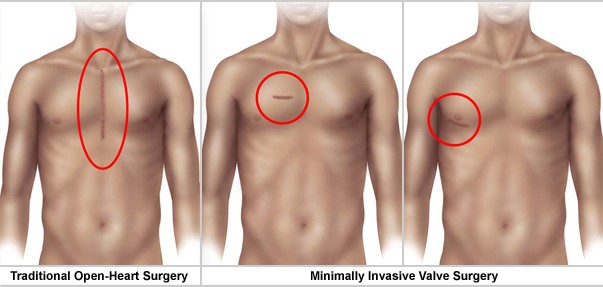Minimally Invasive Heart Surgery

Minimally invasive Surgery involve accessing the heart through small incisions, typically between the ribs or through the sternum (breastbone). This approach offers several advantages over traditional open-heart surgery, including:
- Smaller incisions: Minimally invasive techniques use smaller incisions, resulting in reduced trauma to the chest wall, decreased pain, and a shorter recovery time.
- Reduced blood loss: The risk of blood loss during surgery is minimized with this approach, reducing the need for blood transfusions.
- Faster recovery: Patients who undergo minimally invasive procedures generally experience a quicker recovery time, allowing them to return to their regular activities sooner.
- Lower risk of complications: Minimally invasive techniques can lower the risk of postoperative complications, such as infection and respiratory issues.
- Cosmetic benefits: Smaller incisions lead to less visible scarring, providing cosmetic advantages.
Robotic-assisted surgery is a specialized form of minimally invasive surgery that utilizes robotic systems to enhance surgical precision and dexterity. The surgeon controls robotic arms equipped with surgical instruments through a console. The benefits of robotic mitral valve surgery include:
- Enhanced precision: Robotic systems offer increased precision, stability, and a greater range of motion compared to human hands, allowing for more precise suturing and tissue manipulation.
- 3D visualization: Surgeons have a magnified, high-definition 3D view of the surgical site, providing enhanced visualization of the mitral valve anatomy.
- Reduced tremor: The robotic system filters out hand tremors, allowing for more steady movements during delicate procedures.
- Shorter hospital stay: Robotic-assisted surgery can lead to a shorter hospital stay compared to traditional open-heart surgery.
- Quicker recovery: Patients who undergo robotic procedures often experience a faster recovery and return to normal activities.
INDICATIONS:
Robotic mitral valve replacement and repair procedures may be indicated for various mitral valve conditions. Here are some common indications for robotic mitral valve surgery:
- Mitral Valve Regurgitation: This is the most common indication for mitral valve surgery. Mitral valve regurgitation occurs when the valve does not close properly, allowing blood to leak back into the left atrium. Robotic surgery can be used to repair or replace the mitral valve, depending on the severity and underlying cause of the regurgitation.
- Mitral Valve Stenosis: Mitral valve stenosis refers to the narrowing of the mitral valve, which restricts blood flow from the left atrium to the left ventricle. Robotic surgery may be indicated for mitral valve replacement in cases where the stenosis is severe and other treatment options are not feasible.
- Mitral Valve Prolapse: Mitral valve prolapse is a condition in which the valve leaflets bulge back into the left atrium during ventricular contraction. Robotic surgery can be used to repair the prolapsed valve by correcting the structural abnormalities, such as repairing or reshaping the valve leaflets or the supporting structures (chordae tendineae and papillary muscles).
- Complex Mitral Valve Anatomy: Robotic surgery may be preferred for patients with complex mitral valve anatomy, such as abnormal valve structures, congenital abnormalities, or previous failed repair attempts. The enhanced visualization and dexterity provided by robotic systems can assist surgeons in performing intricate procedures in challenging anatomical situations.
- Mitral Valve Disease in High-Risk Patients: Robotic mitral valve surgery may be considered for patients who are at high risk for traditional open-heart surgery. The minimally invasive nature of robotic surgery can potentially reduce the risks associated with a large chest incision and cardiopulmonary bypass, making it a suitable option for selected high-risk patients.
CONTRAINDICATIONS:
While robotic mitral valve replacement and repair can be a valuable surgical approach for many patients, there are certain contraindications that may make this procedure unsuitable. The following are some common contraindications for robotic mitral valve surgery:
- Severe Coexisting Medical Conditions: Patients with severe comorbidities, such as advanced heart failure, severe lung disease, kidney failure, or liver disease, may not be ideal candidates for robotic mitral valve surgery. These conditions can increase the surgical risks and potential complications.
- Unstable Hemodynamics: Patients who are hemodynamically unstable, with severe heart failure or unstable cardiac rhythms, may not be suitable for robotic surgery. The stability of the patient’s overall cardiovascular system is crucial for successful surgical outcomes.
- Extensive Mitral Valve Damage: In cases where the mitral valve is severely damaged or extensively calcified, robotic surgery may not be feasible. The complexity and extent of the repair or replacement needed may require a more traditional open-heart approach.
- Previous Chest Surgeries: Patients who have undergone previous chest surgeries, especially those with significant adhesions or scarring, may have limited access for robotic instruments. In such cases, a traditional open approach may be preferred.
- Lack of Robotic Surgical Expertise: Robotic mitral valve surgery requires a specialized surgical team with expertise in robotic-assisted procedures. If a hospital or surgeon does not have the necessary training, experience, or access to robotic systems, it may not be a suitable option.
- Patient Preferences and Limitations: Some patients may have personal preferences or limitations that make them unsuitable for robotic surgery. For example, patients who are not comfortable with the use of robotic systems or have contraindications to general anesthesia may not be suitable candidates.